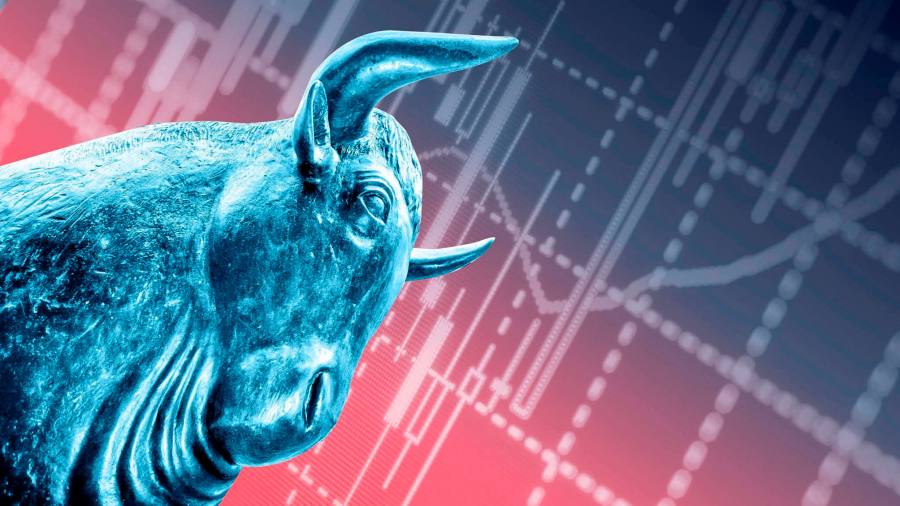Good morning. Goldman’s earnings disappointed the market yesterday. A bad omen for the rest of earnings season? Probably not: investment banking and trading say more about markets than the real economy. Email us: [email protected] and [email protected].
The case for a soft landing
We noted yesterday that markets have felt a bit cheerier to start the year. If you look on the junkiest side of the market — bitcoin, Ark’s long-shot innovation ETF, meme stocks, triple-C yield spreads — the bounce has been especially striking:
Maybe this is just the January effect, but the consensus view on Wall Street is that the probability of a soft economic landing is rising. Unhedged regulars will know we’re sceptical, but it’s hard to deny that, lately, economic news has been good:
-
Inflation is falling. Core CPI, on an annualised monthly basis, dropped from 7.1 per cent in September to 3.7 per cent in December.
-
The labour market is cooling without going cold. The Atlanta Fed’s wage growth tracker shows it falling from 6.7 per cent in August to 6.1 per cent in December. Payroll growth and job openings are both edging down, but remain historically high.
-
Activity is weakening, but not collapsing. The Institute for Supply Management’s purchasing managers’ index for manufacturing dipped into mild contraction in November, followed by the non-manufacturing (services) index in December.
-
China’s reopening will almost certainly give global growth a shot in the arm at some point.
This is not, we would argue, a fact pattern that screams soft landing. But between easing inflation and a resilient economy, there’s enough good data for those of little faith to believe again. Sentiment has been dismal, too — which means stocks can rise when people start to feel a bit better. The chart below shows the American Association of Individual Investors’ weekly survey of bulls and bears. When everyone is so dreary, as they were in late December, there is often only one way for the market to go:
Ed Yardeni of Yardeni Research, a bigshot strategist, has been in the soft landing camp for a while, arguing that the economic data is consistent with moderation in the services sector and “no landing” in the labour market. His Friday blog post, called “Young Bull Market?”, caught our eye:
Last year, we thought that the S&P 500’s bear market might have bottomed at 3,666 on June 16, when sentiment was as bearish as it was when the index bottomed at 666 on an intraday basis on March 6, 2009. We were wrong. It fell to a new low of 3,577 on October 14. We viewed that as a successful retest of the June low.
So far so good. The S&P 500 is up 11.8 per cent since then through today’s close . . . It is back slightly above its 200-day moving average. This is the fourth attempt by the bulls to keep the rally going above its 200-day moving average. We think this one may succeed.
The first two failed to do so as Fed officials turned increasingly hawkish. They are still hawkish, but increasingly perceived to be approaching the terminal rate of the federal funds rate, while the economy remains resilient as inflation continues to moderate.
In other words, markets are ready to rally as the risk of further Fed increases recedes into the background.
Yardeni gives a soft landing odds of three in five. Emmanuel Cau of Barclays points out that markets’ taking a pro-risk stance makes sense (emphasis ours):
Markets may have good reasons to follow the disinflation script. More signs of moderating price pressures are now visible in services, not just in manufacturing, and the job market is showing some cracks . . . There is arguably a long way to go for inflation to return to normal . . . But soft data indicators (ISM/PMIs, NFIB) suggest US activity momentum is slowing more, while inflation expectations are falling. For now, the direction rather than the level of inflation may prevail for market sentiment.
Still, we see three reasons to sell the rally. First, it seems more of a reaction to rate volatility subsiding than a change in economic fundamentals. That is, as the Fed approaches the terminal rate, better inflation data is giving it room to stay where it is, lowering the risk of even higher rates. This chart from Jim Reid of Deutsche Bank shows how much risk assets have tracked the Move index of implied bond volatility, which has calmed down recently:
Lower rate volatility is good for markets in the short term, but it does nothing to change the fact that the Fed raising and holding rates will, after a lag, slam the economy. Reid writes that now could be the “sweet spot” for markets, before the economy turns sour.
Second, even an economy that avoids recession will be bad for corporate earnings. As we’ve written before, margins are too high. Hani Redha, a portfolio manager at PineBridge Investments, says the flipside of inflation coming down is diminished pricing power:
The level of profitability that companies have right now is unsustainable. Margins are off the charts, and that is not because management teams have suddenly turned into geniuses. It’s because of the unique circumstances last year, where we still had very strong demand and supply constraints, which gave [companies] a lot of pricing power and operational leverage. That’s the sunny side of inflation: it’s actually supportive of margins and profitability by giving companies pricing power. But now that everyone’s cheering on the peak in inflation, it actually means you have to unwind and give back that extraordinary rise in profitability. Even if you don’t expect recession, you still have to deal with this margin compression.
Lastly, the problems US equities face do not appear priced in. One simple way to see this is by looking at the equity risk premium — the extra compensation stock investors receive over the risk-free rate. You would think that between high recession risk, the threat of margin compression, improving alternatives in fixed income and much else, equities would be paying a whole lot more than bonds. But no, it’s at a decade low:
Little wonder, then, that allocations to US equities are at a 17-year low. There are some good reasons to be bearish. (Ethan Wu)
Alibaba, buybacks, and Ryan Cohen
Ryan Cohen, a star in the meme-stock firmament, has bought a stake in Alibaba, the Chinese ecommerce giant, and is agitating for change. He wants the company to buy back more of its own shares. The size of his stake is unclear, but is said to be in the hundreds of millions of dollars. This is within Cohen’s means. He sold Chewy, the pet supply company he founded, for $3.35bn five years ago (full disclosure: I order dog toys from Chewy, and my dog seems to like them).
Does Cohen’s activist campaign have a chance of success? My colleagues over at the Lex column have already given the answer, and it is no: “Stakeholder activism tends to be the prerogative of the government in one-party states.” All the more so now, as the one party has begun buying a stake — with special rights — in the company involved.
Alibaba is not going to waste time or energy listening to Cohen. It is conceivable, though, that his meme celebrity may draw US retail investors to Alibaba, pushing the price up. That sort of worked with GameStop (where he became chair) and led to a brief pop in the shares of Bed, Bath and Beyond. Note, though, that Alibaba has a market capitalisation of more than $300bn. Even before their recent declines, both GameStop and BB&B were worth a small fraction of that. The Ape army has its work cut out.
Cohen’s windmill-tilting does however raise an interesting question about an interesting company. Should Alibaba be buying back more of its own shares? It is in the middle of a $45bn programme running through to the end of March 2025, and has bought back $18bn worth already. This question is — always and everywhere — equivalent to the question: “Are the shares undervalued?”
Think of buybacks as buying out partners in a business. Imagine a restaurant with three owners. Two of the owners go to the third and say, we’ll buy your third of the business for $50,000. The deal is done. Are the first two owners now better off? It depends on whether the restaurant is worth more or less than $150,000. Just so with a stock buyback. When a company buys its own shares, the shareholders who don’t sell are left with bigger stakes in a company that has less cash (or more debt). Are they better off? It depends if they bought out the departing shareholders at the right price.
So, is Alibaba undervalued? Hard question; here are some of the crucial issues. As the biggest e-retail platform in China, the company has much to gain from a successful reopening, and the stock is at less than half its 2020 high. Its price/earnings ratio (on 2023 projected earnings) is 16, which looks cheap compared to local rival JD.com and global rival Amazon.com (at 26 and 76, respectively).
On the other hand, its non-core businesses are marginally profitable or not profitable at all. The overall growth rate has been decelerating (though it is hard to know how much of this is down to Covid). And its valuation is not historically low relative to its own history or the wider Chinese market, which it tracks fairly closely in recent years.
Then there is the little problem that foreign “investors” in Alibaba don’t own the company. This would not be allowed under Chinese law. Instead, they have contractual agreements with it, under a “variable interest entity” structure. The “risks” section of Alibaba’s annual report drearily notes that:
The VIE structure has been adopted by many China-based companies . . . to obtain licenses and permits necessary to operate in industries that currently are subject to restrictions on or prohibitions for foreign investment in China . . . there can be no assurance . . . that the VIE structure adopted by us will not be deemed as a method of foreign investment by other laws, regulations and rules.
It is probably impossible to guess whether the Chinese government will resolve the legal ambiguities around the VIE structure in a way that harms foreign investors. It is therefore impossible to say precisely how big a discount foreign shareholders should demand before buying shares. Unhedged’s imprecise answer: a very, very big one.
One good read
Alex Etra and Brad Setser explain why Japanese investors have been selling global bonds, and discuss whether the sales will continue.
Read the full article here



